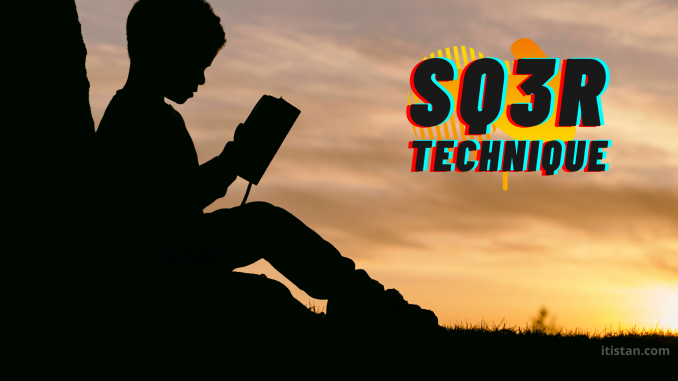
When we talk about learning and reading textbooks, a huge number of students getting it difficult to prepare content. Here below we’re going to discuss SQ3R reading technique.
In 1946, an American educational philosopher Francis P. Robinson introduced SQ3R reading technique in his book “Effective Study”.
Wikipedia
Why to learn SQ3R Reading Technique?
Thoroughly understand this technique and then apply it when you’ll prepare your textbooks. It will help you out in getting highest grades with less effort.
SQ3R or SQRRR stands for:
- “S” for Survey
- “Q” for Question
- “R” for Read
- “R” for Recite
- “R” for Review
Now, let’s see what procedures and details are involved in these steps to easily learn the text.
1. Survey
First character of SQ3R that is “S” stands for survey. In this step, we go through a chapter from text book.
While looking through a chapter, note headings and subheadings. Note prominent features in the chapter; which includes but not limited to diagrams, pictures, tables etc.
Read main idea and summary of the same chapter. It will approximately takes only 3 to 5 minutes. “Survey” phase in SQ3R reading technique provides you an outline of the chapter.
2. Question
Second character of SQ3R that is “Q” stands for question. In this step, we generate questions. The best way is to consider heading and sub-headings listed in previous step to create questions. You can also produce questions like how this chapter will help you?
3. Read
First “R” among 3R’s of SQ3R stands for read. In this step, we read text to find answers of questions generated in “Question” phase. Thoroughly read content of the chapter to find answers of all these questions.
It is different from traditional reading, as we engage with text to clear queries in our mind.
4. Recite
Second “R” among 3R’s of SQ3R stands for recite. In this step, we recite content in our own words.
Basically, we recite main concepts to check it out what we’ve learnt from the textbook. Recite these concepts in your own words like you’re teaching a person. Keep headings, sub-headings and generated answers in mind while reciting your learning.
5. Review
Third “R” among 3R’s of SQ3R stands for review. In this step, we compare our understanding with textbook content. Once again read the textbook content and compare with the concepts you’ve recited in previous step.
You can easily figure it out that how much you’ve learnt accurately. Highlight differences between your concepts and textbook content. Prepare these chunks to increase learning accuracy.
Keep visiting itistan.com for latest updates and information about technology, education and solutions. Happy Learning.
Leave a Reply